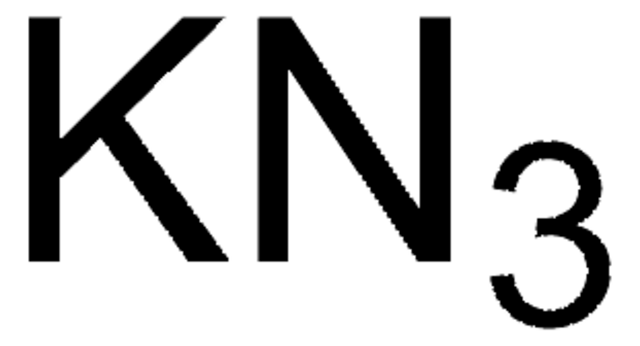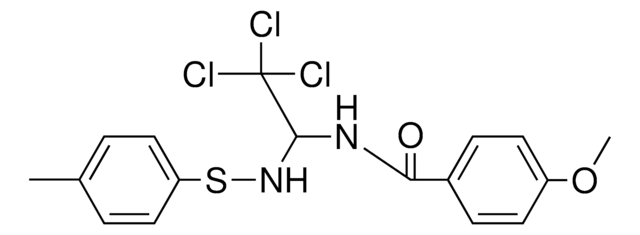S2002
Sodium azide
ReagentPlus®, ≥99.5%
Sinonimo/i:
Hydrazoic acid sodium salt
About This Item
Prodotti consigliati
Origine biologica
synthetic (inorganic)
Livello qualitativo
Nome Commerciale
ReagentPlus®
Saggio
≥99.5%
Stato
powder
Condizioni di stoccaggio
(Tightly closed. Dry. Keep in a well-ventilated place. Do not store near acids.)
tecniche
cell based assay: suitable
immunohistochemistry: suitable
Colore
white
Punto di fusione
370-425 °C
Solubilità
soluble 65 g/L at 20 °C (completely)
Compatibilità
suitable for chromatography
suitable for derivatization
applicazioni
sample preparation
Stringa SMILE
[Na]N=[N+]=[N-]
InChI
1S/N3.Na/c1-3-2;/q-1;+1
PXIPVTKHYLBLMZ-UHFFFAOYSA-N
Cerchi prodotti simili? Visita Guida al confronto tra prodotti
Descrizione generale
Applicazioni
Catalyst for:
- Oxidative decarboxylation
- Michael addition reactions
Reagent for synthesis of
- Blue fluorescent copolymers
- Metal phosphonates
- Arenes via aminations
Azioni biochim/fisiol
Altre note
Note legali
Guanti suggeriti per la protezione dagli schizzi
Prodotto comparabile
Avvertenze
Danger
Indicazioni di pericolo
Consigli di prudenza
Classi di pericolo
Acute Tox. 1 Dermal - Acute Tox. 2 Inhalation - Acute Tox. 2 Oral - Aquatic Acute 1 - Aquatic Chronic 1 - STOT RE 2 Oral
Organi bersaglio
Brain
Rischi supp
Codice della classe di stoccaggio
6.1A - Combustible acute toxic Cat. 1 and 2 / very toxic hazardous materials
Classe di pericolosità dell'acqua (WGK)
WGK 2
Punto d’infiammabilità (°F)
Not applicable
Punto d’infiammabilità (°C)
Not applicable
Scegli una delle versioni più recenti:
Possiedi già questo prodotto?
I documenti relativi ai prodotti acquistati recentemente sono disponibili nell’Archivio dei documenti.
I clienti hanno visto anche
Protocolli
Antibody Purification using Protein A, Protein G, or Protein L Agarose protocol is designed as a quick purification method for antibodies from mammalian sera, ascites, and cell culture supernatants. It should be noted that if the starting material is serum or ascites the final preparation will contain endogenous host IgG as well as specific antibodies. In general, the presence of this endogenous IgG should not interfere with assays using the antibodies.
ELISA protocols providing detailed instructions on performing indirect ELISA and Capture ELISA . Learn more about recommended products and techniques for performing both sandwich ELISA and indirect ELISA experiments.
Calibration Curves for TSKgel® SW mAb Columns
Il team dei nostri ricercatori vanta grande esperienza in tutte le aree della ricerca quali Life Science, scienza dei materiali, sintesi chimica, cromatografia, discipline analitiche, ecc..
Contatta l'Assistenza Tecnica.









![[(3R)-3-Hydroxytetradecanoyl]-L-carnitine analytical standard](/deepweb/assets/sigmaaldrich/product/structures/179/609/9ca2d958-e24e-4810-ab06-b5ee692b43b9/640/9ca2d958-e24e-4810-ab06-b5ee692b43b9.png)